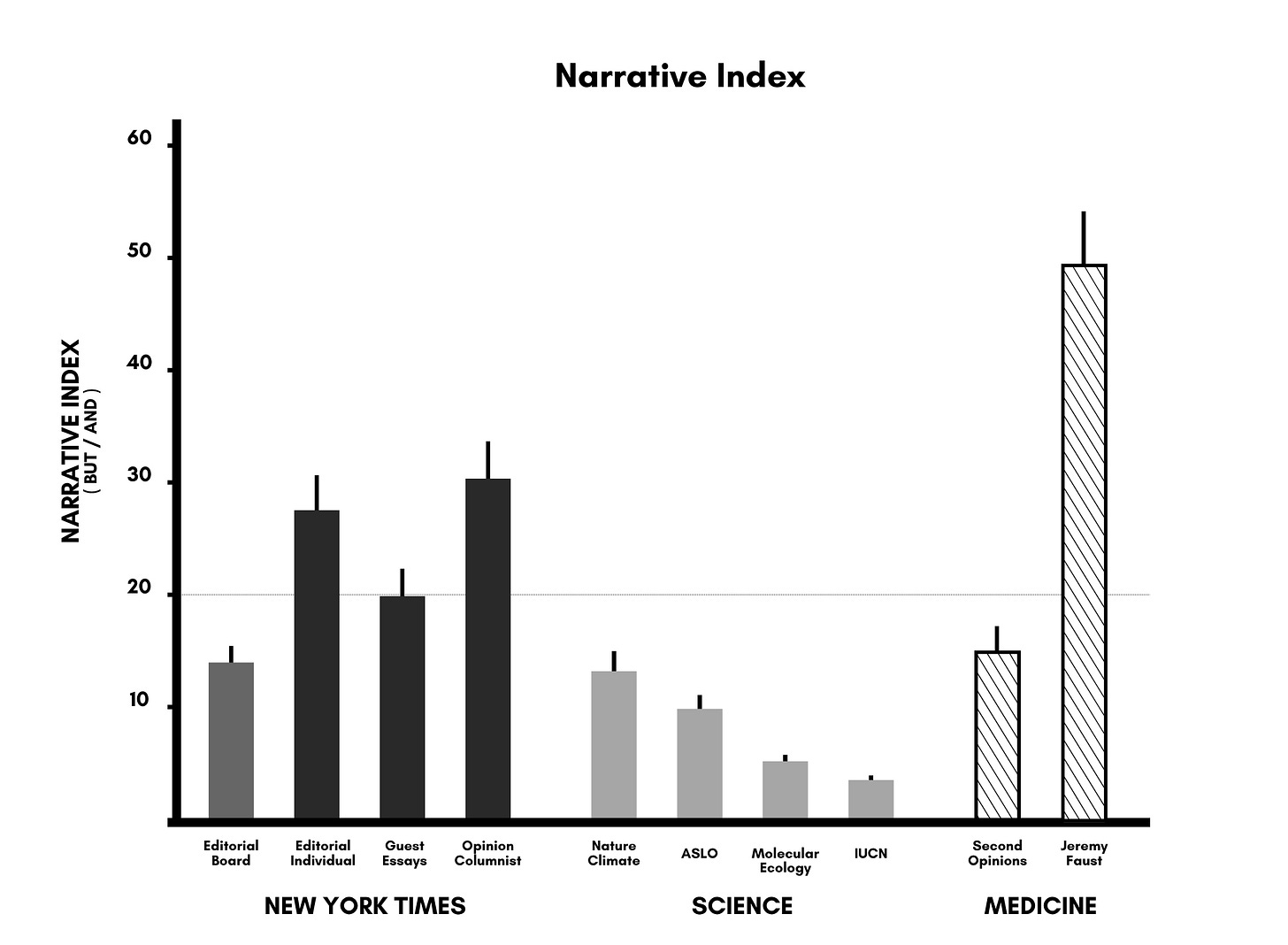Dr. Jeremy Faust: The Narrative Exception That Proves the Rule
NY Times editorials have greater narrative strength than science and medicine, BUT the editorials of Dr. Jeremy Faust are more powerful than all of them. We’ve never seen such narrative strength.

Simple Data, Simple Point: Scientists and Physicians Could Argue Stronger
Our argument here consists of 3 parts. It arises from what we see with the Narrative Index. It goes like this ...
PART 1 - Editorials in the NY Times have considerable narrative strength (NI > 20).
PART 2 - Editorials in science and medical publications have less narrative strength (NI < 20).
PART 3 - QUESTION: Do science and medical editorials HAVE TO HAVE less narrative strength?
THE ANSWER: No. Look at Faust Files, the editorials of , Editor-in-Chief of MedPage. He is the exception showing how high the bar can be set.
The NI Data
The Narrative Index (NI) is derived from the ABT (And, But, Therefore) Narrative Framework which I first introduced in a TEDMED Talk over a decade ago. The use of the ABT for more powerful communication is now spreading throughout the legal world, the business community (cited recently as one of the six top “storytelling models for CEOs”), civil and environmental engineering, medicine (this fall, for the fourth consecutive year, we will be teaching the ABT Framework Course at Emory University Medical School, where it is now a part of their official curriculum), and in science there is now this service that will ABT your abstract. The popular medical publication MedPage Today has actually helped us develop the NI with a number of our articles in recent years including applying the metrics to COVID communication.
The NI is simply the ratio of BUTs to ANDs in a text (you can read about it in detail in our new book). It is:
NARRATIVE INDEX = (BUTs / ANDs) X 100
We measured it for a variety of editorials (25 for each category) using only editorials of over 1,000 words in length with the exception of Nature Communication where we offset the shorter size by measuring 50 of them.
The patterns are clear and result in a simple ABT statement for us which is:
Science/medical editorials are not as strong as political/social editorials in the NY Times, BUT Dr. Jeremy Faust with his Faust Files editorials is a stunning exception THEREFORE science and medicine should view him as a role model and strive to argue with the greater strength and clarity that he demonstrates.
Faust Files: the Exception That Proves the Rule
We have calculated the NI for literally thousands of editorials, speeches, articles, books, standup comedy performances, commencement addresses and … we’ve never seen a collection of scores like his.
Faust Files editorials averaged a stunning 47. This is fifty percent higher than the best of the New York Times columnists.
Why might this be? Why might he be drawing on the power of narrative even more than the best?
Two obvious answers. The first is the urgency of the material he is arguing, week after week. Is it “life and death” material? Yes. Of course it is. His editorials are frequently about national health crises, especially COVID.
Just look at the three highest scores we found and what he is saying in each piece. All of them have solid messages built around a core contradiction.
His highest scores are a 95 (“Everyone is talking about COVID BUT here’s a headline being neglected”), an 85 (“We should do no net harm, BUT even that isn’t enough”), and an 80 (“COVID levels are low, BUT obviously it won’t last”).
Second, excellent communication requires both the informational (cerebral) element as well as the narrative structure (visceral) element. He has the impeccable academic credentials on the cerebral side, but also the real-world visceral strength through his work as an emergency physician.
Dr. Faust appears to be the role model that leaves the others with limited excuses for their lesser scores. We’ll leave it at that. The Narrative Index is such a simple calculation it’s hard to argue with.




Showing us what we already knew was true.♥️